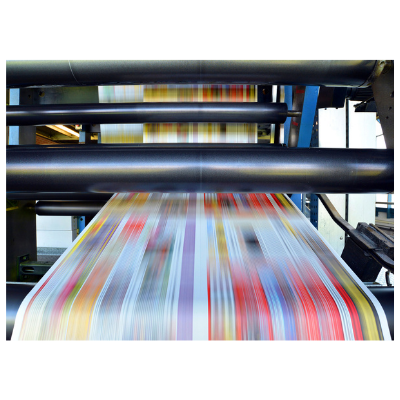Earlier in this series, we took in-depth looks at both flexography and offset lithography printing.
As a refresher, flexography is a direct printing method, sometimes compared to inking a rubber stamp and impressing it on paper. Lithography is an offset or indirect printing method where an inked plate transfers the image to a blanket, which then makes contact with the substrate (and allows for higher screen values and better overall print quality).
Knowing these basics differences between flexography and offset lithography can help set the stage for determining which print process is right for your job. However, understanding the intricacies of how print processes work in relation to your specific artwork can help provide an understanding of why a given print process is best for your envelope project.
Design and the Envelope Printing Process
Below are important design components to consider for your envelope project:
- The Artwork – Your artwork plays a major role in determining which print method is optimal for your envelope project. In envelope printing, trapping, or the ability to print ink over previously printed ink, can refer to how much overprinted colors overlap in order to eliminate white lines between colors during printing. When discussing your print needs in relation to your artwork, consider questions such as: Does the artwork have heavy coverage? Do any of the images have two or more colors touching? Does the artwork require fine print registration? How many colors does your project require?
- Color Requirements – Determine if your color requirements involve spot colors, colors assigned by the Pantone Matching System (PMS colors), or process colors created from CMYK (cyan, magenta, yellow and black). Flexographic presses print spot colors. Depending on the press, four-color process (CMYK) printed jobs can also be printed on flexographic presses, yielding high-quality print and similar results as offset lithography. However, if your artwork calls for process (CMYK) colors and contains fine screens, offset lithography may be the best choice.
- Paper/Substrate – The most common envelope paper, 24 lb. white wove, is a porous substrate, and often ideal for spot colors printed on flexographic presses. However, if your design requires process colors that are overlayed to achieve a specific color, you will want to explore options. Offset lithography printing often uses calendarized or smooth, coated paper so the ink does not absorb into the paper and is able to produce a higher quality print result.
- Screens – A halftone is the representation of an image as small, clearly defined dots; screens are the reproduction of halftones on printing plates as dot structures with graduated densities. Designs that feature fine screens often call for high quality print technology, such as offset lithography, to achieve proper image reproduction on paper. Why? When a design features bold, black text with a gray screen that requires a percentage of the black ink, the print impression must be exact since there are so many variables on the printing plate; plates need to exhibit tight print registration and light printing pressure for the screen to properly transfer.
- Plate Material – Photopolymer CYREL® plates can print around 85-100 lpi screens and are found on flexographic printing presses. When images have lots of screens or a great amount of detail (e.g. images of faces), digital plates are ideal because they allow for the creation of finer screens, processed images and an overall a sharper image. Digital plates can also be used on flexographic presses, as well as offset lithography presses.
Contact Us
The experts at Tension are well-versed in how to best manage your envelope print project to achieve your business goals. Contact us today to get started.




